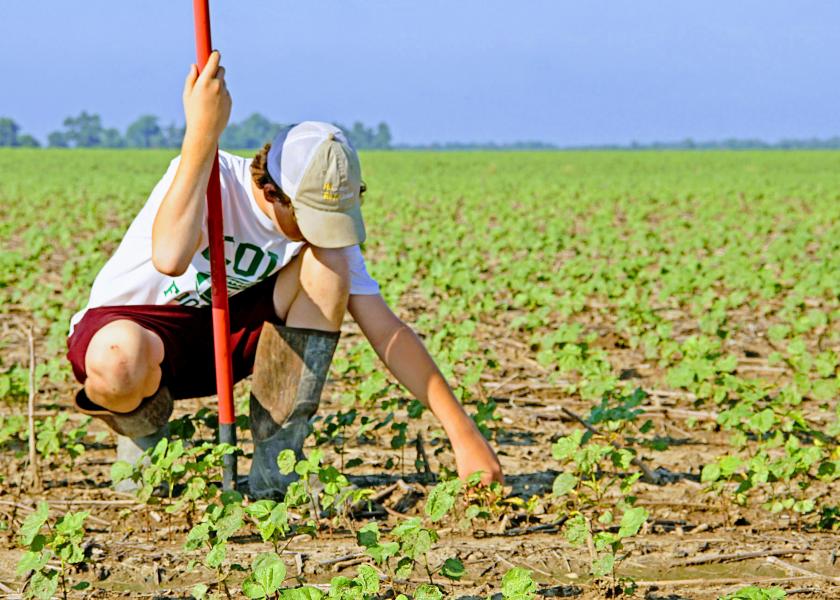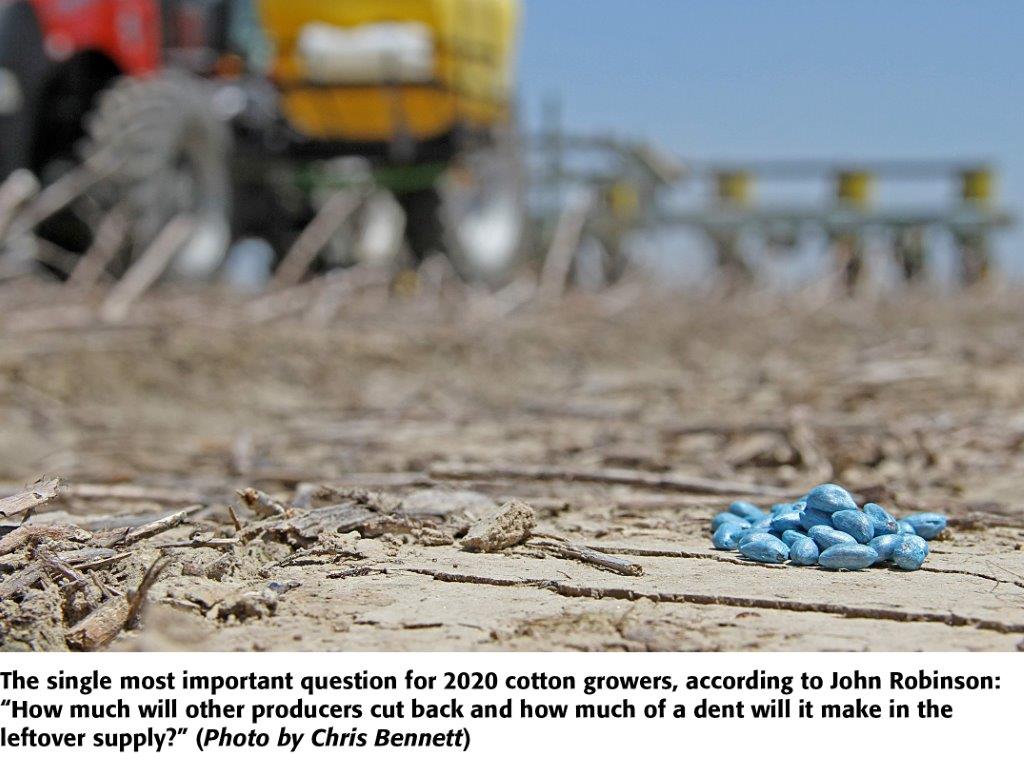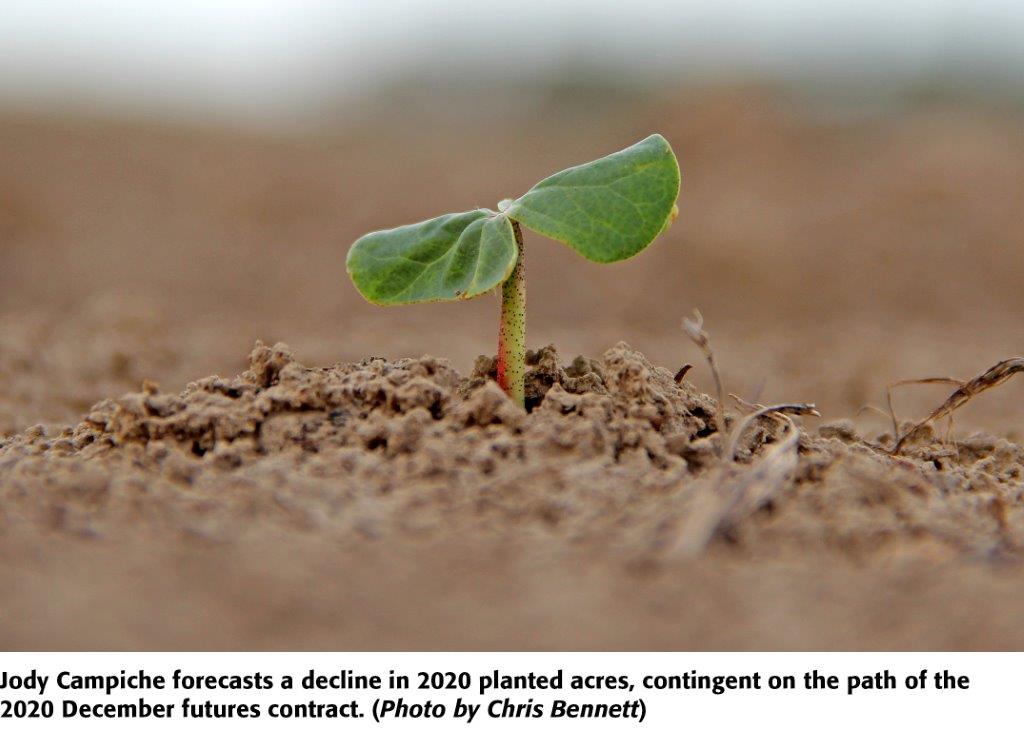Cotton Acreage Plunge in 2020?

How deep a dip for cotton acreage in 2020? With producers saddled by anemic prices and the ongoing U.S.-China trade dispute, a cotton cut up to 3 million acres is a possibility.
Despite cotton reaching almost 14 million planted acres in 2019 (2.7% less than 2018 acreage), the white blanket may not cover 11 million acres in 2020. Two leading cotton analysts offer perspective on major 2020 production issues, potential acreage and market wild cards.
Below 11 Million?
Texas A&M University Extension cotton economist John Robinson projects the big picture for 2020 centered on dual pillars—China and acreage cuts. First, the tariff clash with China has hit U.S. producers in both a direct and indirect manner; a one-two punch, as Robinson describes: “Will there be resolution in the U.S.-China dispute in 2020? It’s had direct effects where Brazil has picked up market share, but that doesn’t necessarily hurt the fundamentals of the market. Still, the indirect effects of the trade are a drag on demand that raises prices on consumers, and places cotton shippers and merchants in a very uncertain business climate.”

What might be the effects on U.S. cotton if the China clash is settled in the early months of 2020, or even at any point in the calendar year? Resolution would mean the beginnings of repair, and not a quick jump to health, Robinson contends. “If the trade war ends, I don’t think markets will go up and stay up. I think they’ll go up and probably come back down. It’s a longer-term fix to get us back to a good situation. This has been an issue the last couple of years and it will be an issue in 2020. China is a market wild card and the situation could get worse; it could get better.”
Second, a looming acreage cut may play a heavyweight role in 2020. “More than anything, reduced acreage has potential to raise prices in 2020, and right now, I believe acreage may drop 2 to 3 million acres,” Robinson says. “If it happens, we’re going to wind up reducing our leftovers—our end stocks—by a couple million bales and that should be price supportive. I could see as few as 10 or 10.5 million acres, from almost 14 million acres in 2019. Certainly, I could see acreage somewhere below 11 million.”
The single most important question for 2020 cotton growers, according to Robinson: “How much will other producers cut back and how much of a dent will it make in the leftover supply?”
Extent of Decline?
For over a decade, China has been a crucial market for U.S. cotton fiber exports. With cotton prices down approximately 30% since the beginning of the U.S.-China trade dispute, Jody Campiche, vice president of economics and policy analysis for the National Cotton Council, provides a detailed look at the clash and its implications. “For the 2018 and 2019 crop years, U.S.-origin cotton has been less competitive relative to growth from countries such as Australia, Brazil and India due to the imposition of the 25% tariff,” she explains.

“The current trade dispute with China and the resulting retaliatory tariffs on U.S. cotton and cotton yarn are increasingly harming the U.S. cotton industry and long-term market share in China. The immediate impact has been a decline in market share of China’s cotton imports from 45% for the 2016 and 2017 crops, down to 18% for the 2018 crop, while Brazil’s market share increased from 7% in 2017 to 23% in 2018,” Campiche continues. “This lost market share has reduced overall export sales and shipments, further depressing U.S. cotton prices.”
The retaliatory tariffs and uncertainty facing the textile supply chain reduced global cotton demand for the 2018 and 2019 crop years, Campiche notes. Prior to the U.S.-China trade dispute, USDA was estimating a record level of world mill use near 128 million bales. “Since September 2018, USDA has lowered, and continues to lower, world mill use projections. For the 2018/2019 crop year, world mill use is estimated to be just over 120 million bales, almost 8 million bales lower than earlier estimates.”
“Mill use for the 2019/2020 crop year is now currently estimated at 121.5 million bales, more than 4 million bales lower than USDA’s previous projection announced in May 2019, and could be further reduced as world mill use continues to struggle,” she adds. “Without a resolution to the U.S.-China trade dispute in the near future, merchants could be faced with additional cancellations and defaults for the 2019 marketing year.”
Although export sales and shipments were reduced for the 2018/2019 crop year, “Sales for the 2019/2020 crop year are currently very strong, but we could see cancellations or the sales could be shifted to the 2020/2021 crop year from China if the tariffs remain in place,” Campiche says.

She forecasts a decline in 2020 planted acres, contingent on the path of the 2020 December futures contract: “The cotton to corn and cotton to soybean price ratio is generally a good indicator of changes in planted cotton acreage. Based on current November/December 2020 futures prices, the ratios are lower than the 2019/2020 crop year, so a decline in cotton acreage is likely for 2020. However, the extent of the decline will depend on the path of the 2020 December futures contract, which is currently trading close to 68 cents per pound.”
In conclusion, Campiche offers three possibilities as wild card factors. One, a resolution to the U.S.-China trade dispute, and potential purchases of U.S. cotton. Two, an increase in cotton demand if trade resolution is achieved. Three, any significant production issues in foreign cotton-producing countries.
For more, see:
Corn Maverick: Cracking the Mystery of 60-Inch Rows
Descent Into Hell: Farmer Escapes Corn Tomb Death
Killing Hogzilla: Hunting a Monster Wild Pig
Breaking Bad: Chasing the Wildest Con Artist in Farming History
Blood And Dirt: A Farmer's 30-Year Fight With The Feds
American Farmer Snuffed Out Saddam Hussein
Against All Odds: Farmer Survives Epic Ordeal
Future Shock: Farmers Exposed By US-China Long Game
Wild Pig Wars: Controversy Over Hunting, Trapping in Missouri
Agriculture's Darkest Fraud Hidden Under Dirt and Lies
In the Blood: Hunting Deer Antlers with a Legendary Shed Whisperer







